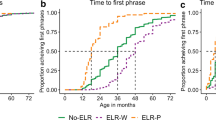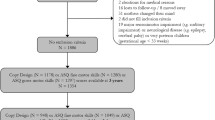Abstract
Most international adoptees (IA) have rapid catch-up of the delays common at arrival. However, it is not known whether development at arrival predicts later abilities or school readiness. Therefore, we comprehensively evaluated language, fine motor, visual reception (VR), executive function (EF), attention (ATT), and sensory skills (SS) in IA preschoolers. We hypothesized that pre-adoptive risk factors, development at arrival, and the post-adoptive environment (time in day care) would predict developmental and behavioral outcomes and school readiness. 37 IA (12M:25F), currently age 4–5 years and previously seen in our clinic (mean arrival age 12 months), were evaluated with standardized tests of development, language, EF, ATT, and SS, along with demographic information, parent interview, and review of arrival clinic records. Fine motor and VR skills at arrival ranged from average to very below average. At followup, most IA were average or above average in fine motor, VR, and language skills, but many had concerning scores for ATT (42%), EF (11%) and SS (48%). Arrival expressive language T scores (Mullen) predicted follow-up scores for expressive language (PLS-4, r = .44, p = .005). Arrival fine motor scores (Mullen) correlated with follow-up auditory comprehension scores (PLS-4, r = .47, p = .002) and inversely with inattention scores (Conners’, r = −.48, p = .003). Arrival visual reception scores correlated inversely with global measures of attention (Conners’ opposition r = −.45, p = .005, ADHD scores r = −.49, p = .002, and to a lesser extent hyperactivity r = −.35, p = .03). Age at arrival was a very strong predictor of many of the outcome measures tested, including language performance, attention regulation, executive function, and sensory processing. Children who spent more time in daycare had significantly more difficulty with emotional control (p = .005). Although IA have good catch-up in specific areas of development, difficulties with ATT regulation, EF, and sensory processing may increase the risk of later school problems.


Similar content being viewed by others
References
Immigrant visas issued to orphans coming to the US (2008) Available at: http://travel.state.gov/adopt.html. Accessed 15 Aug 2008
Miller LC (2005) The handbook of international adoption medicine. Oxford University Press, New York
Johnson DE (2002) Adoption and the effect on children’s development. Early Hum Dev 68(1):39–54
Johnson D (2000) Medical and developmental sequelae of early childhood institutionalization in Eastern European adoptees. In: Nelson CA (ed) The effects of early adversity on neurobehavioral development. Lawrence Erlbaum Associates, Mahwah
Dawson G, Ashman SB, Carver LJ (2000) The role of early experience in shaping behavioral and brain development and its implications for social policy. Dev Psychopathol 12(4):695–712
Gunnar MR (1998) Quality of early care and buffering of neuroendocrine stress reactions: potential effects on the developing human brain. Prev Med 27(2):208–211
Gunnar MR, Bruce J, Grotevant HD (2000) International adoption of institutionally reared children: research and policy. Dev Psychopathol 12:677–693
Nelson CA, Zeanah CH, Fox NA, Marshall PJ, Smyke AT, Guthrie D (2007) Cognitive recovery in socially deprived young children: the Bucharest early intervention project. Science 318:1937–1940
Davies D (2004) Child development—a practitioner’s guide. Guilford Press, New York
Shonkoff JP, Phillips DA (eds) (2000) From neurons to neighborhoods. National Academy Press, Washington
Greenough WT, Black JE, Wallace CS (1987) Experience and brain development. Child Dev 58:539–559
Newport EL (1990) Maturational constraints on language learning. Cog Sci 14:11–28
Levay S, Weisel TN, Hubel DH (1980) The development of ocular dominancy columns in normal and visually deprived monkeys. J Comp Neurol 19:11–51
Albers LH, Johnson DE, Hostetter MK, Iverson S, Miller LC (1997) Health of children adopted from the former Soviet Union and Eastern Europe. Comparison with pre-adoptive medical records. JAMA 278(11):922–924
Carlson M, Earls F (1997) Psychological and neuro-endocrinological sequelae of early social deprivation in institutionalized children in Romania. Ann N Y Acad Sci 807:419–428
Cermak SA, Daunhauer LA (1997) Sensory processing in the post-institutionalized child. Am J Occup Ther 51(7):500–507
Gunnar MR, van Dulmen MHM, The International Adoption Project Team (2007) Behavior problems in post-institutionalized internationally adopted children. Dev Psychopathol 19:129–148
Judge S (2003) The impact of early institutionalization on child and family outcomes. Adopt Q 7(3):31–48
Juffer F, van IJzendoorn MH (2005) Behavior problems and mental health referrals of international adoptees. JAMA 293(20):2501–2515
Kadlec MB, Cermak S (2002) Activity level, organization, and social-emotional behaviors in post-institutionalized children. Adopt Quarterly 6:43–57
Lin S, Cermak S, Coster WJ, Miller LC (2005) The relationship between length of institutionalization and sensory integration in children adopted from Eastern Europe. Am J Occup Ther 59(2):139–147
McGuinness T, McGuinness J (1999) Speech and language problems in international adoptees. Am Fam Physician 60(5):1322–1323
Morison SJ, Ames EW, Chisholm K (1995) The development of children adopted from Romanian orphanages. Merrill Palmer Q 41(4):411–430
O’Connor TG, Rutter M, Beckett C, Keaveney L, Kreppner JM (2000) The effects of global severe privation on cognitive competence: extension and longitudinal follow-up. English and Romanian Adoptees Study Team. Child Dev 71(2):376–390
Rutter M, Andersen-Wood L, Beckett C et al (1999) Quasi-autistic patterns following severe early global privation. English and Romanian Adoptees (ERA) Study Team. J Child Psychol Psychiatry 40(4):537–549
Stams GJ, Juffer F, Rispens J, Hoksbergen RA (2000) The development and adjustment of 7-year-old children adopted in infancy. J Child Psychol Psychiatry 41(8):1025–1037
Tirella LG, Chan W, Miller LC (2006) Educational outcomes of 8–12 year old children adopted from Eastern Europe. J Res Child Educ 20(4):245–254
van Londen WM, Juffer F, van IJzendoorn MH (2007) Attachment, cognitive, and motor development in adopted children: short-term outcomes after international adoption. J Pediatr Psychol 32(10):1249–1258
Miller LC, Chan W, Tirella LG, Perrin E (2009) Outcomes of children adopted from Eastern Europe. Internat J Behav Dev 33
Castle J, Groothues C, Bredenkamp D, Beckett C, O’Connor T, Rutter M (1999) Effects of qualities of early institutional care on cognitive attainment. E.R.A. Study Team. English and Romanian Adoptees. Am J Orthopsychiatry 69(4):424–437
Croft C, Beckett C, Rutter M et al (2007) Early adolescent outcomes of institutionally-deprived and non-deprived adoptees. II: Language as a protective factor and a vulnerable outcome. J Child Psychol Psychiatry 48(1):31–44
Judge S (2003) Developmental recovery and deficit in children adopted from Eastern European orphanages. Child Psychiat Hum Dev 34(1):49–62
Rutter M, Colvert E, Kreppner J et al (2007) Early adolescent outcomes for institutionally deprived and non-deprived adoptees. I: Disinhibited attachment. J Child Psychol Psychiatry 48(1):17–30
Verhulst FC, Althaus M, Versluis-Den Bieman HJM (1990) Problem behavior in international adoptees: an epidemiologic study. J Am Acad Child Adolesc Psychiatry 29(1):94–103
Verhulst FC, Versluis-Den Bieman HJM, Van der Ende J, Berden GFMG, Sanders-Woudstra JAR (1990) Problem behavior in international adoptees: III. Diagnosis of child psychiatric disorders. J Am Acad Child Adolesc Psychiatry 29:420–428
Beverly BL, McGuinness T, Blanton DJ (2008) Communication and academic challenges in early adolescence for children who have been adopted from the former Soviet Union. Lang Speech Hear Serv Sch 39:303–313
Keyes MA, Sharma A, Elkins IJ, Iacono WG, McGue M (2008) The mental health of US adolescents adopted in infancy. Arch Pediatr Adolesc Med 162(5):419–425
Mullen EM (1995) Mullen scales of early learning. American Guidance Services, Circle Pines
Carter AS, Briggs-Gowan MJ (2006) Manual for the infant-toddler social & emotional assessment (ITSEA)—Version 2. Psychological Corporation, Harcourt Press, San Antonio
Zimmerman I, Steiner V, Pond R (2002) Preschool language scale-4. Harcourt Assessment Co., San Antonio, TX
U.S. Department of Health and Human Services (2009) Child development assessment tools. http://www.acf.hhs.gov/programs/opre/ehs/perf_measures/reports/resources_measuring/res_meas_cdibb.html. Accessed 2 Jun 2009
Conners CK (1997) Conners’ rating scales revised. Multi-Health Systems, North Tonawanda
Gioia GA, Espy KA, Isquith PK (2002) Behavior rating inventory of executive function, preschool version (BRIEF-P). Psychological Assessment Resources, Odessa
Dunn W (1999) Sensory profile (3–10 years). Harcourt Assessments, Inc, San Antonio
Centers for Disease Control and Prevention. Epi Info 2004 Version 3.2.2. www.cdc.gov/epiinfo
Miller LC, Hendrie NW (2000) Health of children adopted from China. Pediatrics 105(6):E76
Miller LC, Kiernan MT, Mathers MI, Klein-Gitelman M (1995) Developmental and nutritional status of internationally adopted children. Arch Pediatr Adolesc Med 149(1):40–44
Chisholm K (1998) A three year follow-up of attachment and indiscriminate friendliness in children adopted from Romanian orphanages. Child Dev 69(4):1092–1106
Snowling MJ, Bishop DV, Stothard SE, Chipchase B, Kaplan C (2006) Psychosocial outcomes at 15 years of children with a history of speech-language impairment. J Child Psychol Psychiatry 47(8):759–765
Stevenson J (1984) Predictive value of speech and language screening. Dev Med Child Neurol 26(4):528–538
Aram DM, Nation JE (1980) Preschool language disorders and subsequent language and academic difficulties. J Commun Disord 13(2):159–170
Aram DM, Ekelman BL, Nation JE (1984) Preschoolers with language disorders: 10 years later. J Speech Hear Res 27(2):232–244
Tizard B, Cooperman O, Joseph A, Tizard J (1972) Environmental effects on language development: a study of young children in long-stay residential nurseries. Child Dev 43:337–358
Huttenlocher J (1998) Language input and language growth. Prev Med 27(2):195–199
Tirella LG, Chan W, Litvinova A, Cermak S, Miller LC (2008) Time use in a Russian orphanage. Child Care Health Dev 34(1):77–86
Dubrovina I (1991) Psychological development of children in orphanages (“Psichologicheskoe razvitie vospitanikov v detskom dome”). Prosveschenie Press, Moscow
Glennen SL (2002) Language development and delay in internationally adopted infants and toddlers: a review. Am J Speech Lang Pathol 11:333–339
Glennen SL, Masters MG (2002) Typical and atypical language development in infants and toddlers adopted from Eastern Europe. Am J Speech Lang Pathol 11:417–433
Glennen SL (2005) Five years later: language in school-age internationally adopted preschoolers. Semin Speech Lang 26(1):86–101
Gindis B (1998) Language related issues for international adoptees and adoptive families. In: Tepper T, Hannon L, Sandstrom D (eds) International adoption: challenges and opportunities. PNPIC, Meadow Lands, pp 98–108
Rygvold A-L (1999) Intercountry adopted children’s language and academic skills. In: Rygvold A-L, Dalen M, Saetersdal B (eds) Mine–yours–ours and theirs. University of Oslo, Oslo, pp 221–229
Miller LJ, Coll JR, Schoen SA (2007) A randomized controlled pilot study of the effectiveness of occupational therapy for children with sensory modulation disorders. Am J Occup Ther 61(2):228–238
Tepper T (ed) (2002) Executive function: http://www.pnpic.org/exec_fun.htm parent network for the post-institutionalized child
Stevens S, Sonuga-Barke EJS, Kreppner J et al (2008) Inattention/overactivity following early severe institutional deprivation: presentation and associations in early adolescence. J Abnorm Child Psychol 36(3):385–398
Colvert E, Rutter M, Kreppner J, et al (2008) Do theory of mind and executive function deficits underlie the adverse outcomes associated with profound early deprivation? Findings from the English and Romanian Adoptees Study. J Abnorm Child Psychol 36(7):1057–1068
Miller LC (2000) Initial assessment of growth, development, and the effects of institutionalization in internationally adopted children. Pediatr Ann 29(4):224–232
Acknowledgments
We gratefully acknowledge the statistical assistance of Robin Ruthazar and the data entry of Brendan Gilligan.
Author information
Authors and Affiliations
Corresponding author
Rights and permissions
About this article
Cite this article
Jacobs, E., Miller, L.C. & Tirella, L.G. Developmental and Behavioral Performance of Internationally Adopted Preschoolers: A Pilot Study. Child Psychiatry Hum Dev 41, 15–29 (2010). https://doi.org/10.1007/s10578-009-0149-6
Received:
Accepted:
Published:
Issue Date:
DOI: https://doi.org/10.1007/s10578-009-0149-6




